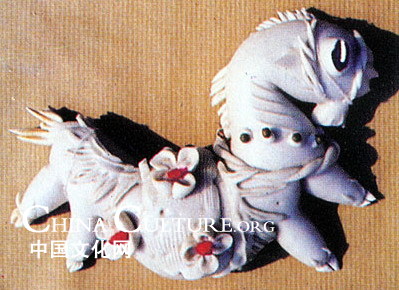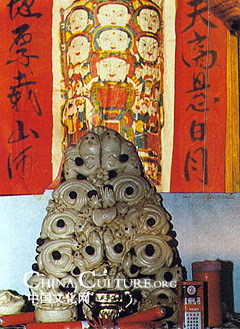The edible artistic works: dough sculptures
Molding human figures and animals from clay or glutinous rice flour is a popular folk art in both urban and rural areas in China.
History
Origin
Written records on Chinese dough sculptures date back to the Han Dynasty (206BC-AD220).
Importance
 |
After several thousand years of inheritance and development, dough sculpture s became a part of Chinese culture and folk arts, and also objects for study in history, archeology, folk arts, sculpture and aesthetics. In terms of style, dough sculptures in the Yellow River Valley are simple, crude, unconstrained and profound, while those in the Yangtze River Valley are delicate, exquisite and polished.
Making Process
Materials and Tools
Materials and tools used in making dough sculptures mainly include white flour, scissors, a kitchen knife, comb, Chinese dates and Bunge prickly ash. With well-leavened dough, kneaded according to the set pattern, one can produce a vivid dough sculpture.
Tips
During the process, there are three tips for making the perfect dough sculpture.
First, the honey, lard, powdered sugar and refined powder are made soluble by adding boiling water, then all is mixed in together with the flour. Edible pigments to form pastes of different colors are added during this stage.
 |
Second, the pastes are steamed for two to three minutes. Care is taken not to cook them for too long as they can become lusterless.
Third, some oil is smeared on the dough sculptures with a brush to make them gleam and more vivid.
Popularity
 |
Dough sculptures are popular wedding and birthday gifts. They are also considered appropriate for prayer and memorial ceremonies and sacrificial offerings. Farmers place steamed dough sculptures before spirit tablets. Today, dough sculptures often appear among dishes on high-grade banquets to beautify and decorate the dishes, and add foils to the banquet atmosphere.
Dough Sculptures in Different Areas
Shanxi Dough Sculptures
The Shanxi people, famous for their rich variety of dishes made from wheat, aside from making various food with dough, also mold it into various "dough figures" to admire as well as for good luck. They send them to friends as gifts to extend lotions or pay tribute to gods. The dough figures are therefore also called edible artistic works.
 |
The typical dough sculpture of northern Shanxi Province is the pudgy baby. The dough is fermented and steamed to depict the crawling, running and lovely gestures of the baby. The pudgy baby is usually used for ancestral sacrifice on the 15th day of the seventh Chinese lunar month (usually in August) to pray for a happy family life.
















